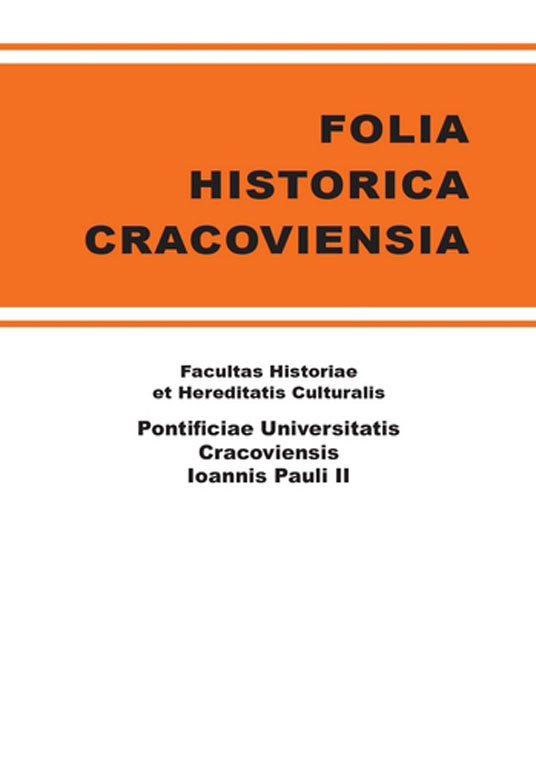Kryzys i reforma życia zakonnego XIV–XVI wieku i jego wpływ na dominikański klasztor łęczycki
DOI:
https://doi.org/10.15633/fhc.218Słowa kluczowe:
reforma życia zakonnego, XIV-XVI wiek, klasztor dominikanów w ŁęczycyAbstrakt
Although to a lesser degree, the 14th century crisis of religious life also embraced Mendicant Orders, including the Order of Preachers. Dominican brothers were obliged to respect the principles written down in the rule of St Augustine as well as in the constitution of the order which regulated the life of the Order as well as defined the Order’s organizational structure. Friars however, sometimes gave in to temptation and broke the rules of their communities. The convents’ style of life with characteristic disregard for the notion of religious community in the order and omnipresent individualism in every field was in conflict with the spirit and content of the rules and constitution of the Dominican, and was referred to as conventualism. The call to initiate a thorough reform of the law in the Order was given by Master General Raymond of Capua. At his command in every Dominican province within one year one monastery with at least 12 brothers was required to introduce the rule of regular observance – the renewal of relations from the period of the formation of the Order and strict adherence (observare) to the Order’s rules. The basic condition of the observance was enclosure. Observant Convents were excluded from the authority of the Provincial and subjected to the power of vicars designated by the Master General. This led to the creation of separate congregations sometimes uniting reformed monasteries from different provinces and countries.
In the Polish province the observant reform officially began on 30 July 1432 in the Wroclaw monastery of St. Adalbert. The success of the reform was confirmed by Chelmno Chapter in 1519 only in the orders in Glogow, Legnica, Krosno (part of Silesia province) as well as in part of Mazovia province, whereas the entire division of the province of Greater Poland together with the Łęczyca monastery was subjected to special care of Andrew from Parczew. The same chapter tells Vicar General of the province to re-visit the convents and reintroduce the reform. The negative effects of the collapse of observance by Łęczyca Friars Preachers were serious and they appeared immediately. The convent had never exceeded the number of 12 monks present at one time till the end of its existence in 1799.
There were several reasons for the fall of observance in Poland: the reform was superficial in its character, both conventualists and observants were under the authority of the provinces, small convents were poverty stricken. According to J. Kłoczowski the initiators of the reform wrongfully restricted the reform to moral issues only, ignoring the structural aspect. It led to many monks behave passively towards the attempts to introduce observance.
Pobrania
Opublikowane
Numer
Dział
Licencja
Prawa autorskie (c) 2012 Tomasz Stolarczyk

Praca jest udostępniana na licencji Creative Commons Attribution-NonCommercial-NoDerivatives 3.0 Unported License.
Twórca oświadcza, że przysługują mu prawa autorskie do utworu i że nie są ograniczone w zakresie objętym niniejszym oświadczeniem oraz że utwór jest dziełem oryginalnym i nie narusza praw autorskich innych osób.
Twórca zezwala Uniwersytetowi Papieskiemu Jana Pawła II w Krakowie na nieodpłatne, niewyłączne i nieograniczone w czasie korzystanie z utworu, to jest:
- utrwalanie i zwielokrotnianie: wytwarzanie egzemplarzy utworu techniką drukarską, reprograficzną, zapisu magnetycznego oraz techniką cyfrową;
- obrotu oryginałem albo egzemplarzami, na których utwór utrwalono (wprowadzanie do obrotu, użyczenie lub najem oryginału albo egzemplarzy, publiczne wystawienie, wyświetlenie, a także publiczne udostępnianie utworu w taki sposób, aby każdy mógł mieć do niego dostęp w miejscu i w czasie przez siebie wybranym);
- włączenie utworu w skład utworu zbiorowego;
- udzielanie przez Uniwersytet Papieski Jana Pawła II w Krakowie sublicencji Creative Commons Uznanie autorstwa 4.0 Międzynarodowe (CC BY 4.0)
Uniwersytet Papieski Jana Pawła II w Krakowie udostępnia utwór na Platformie Czasopism należącej do uczelni, na licencji Creative Commons Uznanie autorstwa 4.0 Międzynarodowe (CC BY 4.0). Tym samym uprawnia wszystkich zainteresowanych do korzystania z utworu pod następującymi warunkami:
- zostanie podany autor i tytuł utworu,
- zostanie podane miejsce publikacji (tytuł czasopisma i identyfikator DOI oryginalnie opublikowanego utworu).

